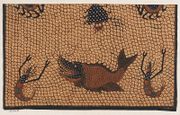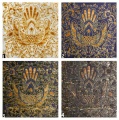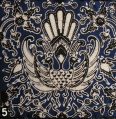Difference between revisions of "Batik"
Jump to navigation
Jump to search
| Line 21: | Line 21: | ||
File:Batik_App.1986_final.jpg|Closer view of above Batik sample | File:Batik_App.1986_final.jpg|Closer view of above Batik sample | ||
File:11.1296_vein.resist-print.jpg|Expanded view<br>MFA 11.1296 | File:11.1296_vein.resist-print.jpg|Expanded view<br>MFA 11.1296 | ||
| − | File:21.538_batik_wax.resist_det.jpg| | + | File:21.538_batik_wax.resist_det.jpg|Expanded view<br>MFA# 21.538 |
| + | File:Batik black and white MFA931452.jpg|Black and white pattern for # 93.1452 | ||
</gallery> | </gallery> | ||
[[Category:Materials database]] | [[Category:Materials database]] | ||
Revision as of 08:43, 23 October 2020
Description
A wax-resist-dyed textile. The batik technique for dyeing textiles originated in southeast Asia. It is still commonly found in Indonesia (especially Java), Malaysia, India, Sri Lanka, and Thailand. The pattern is applied to the cloth with melted wax, the the fabric is dipped in dye. Sometimes a series of wax/dye steps are used. The wax is removed with a solvent or ironed between paper towels.
Synonyms and Related Terms
batique; resist-dyed textile; Batik (Deut., Fr., Port., Sven.); batikken (Ned.);









